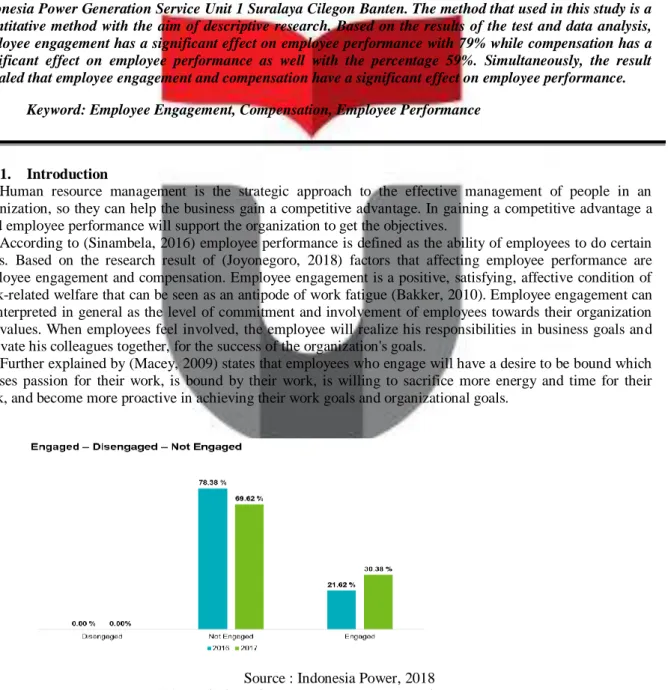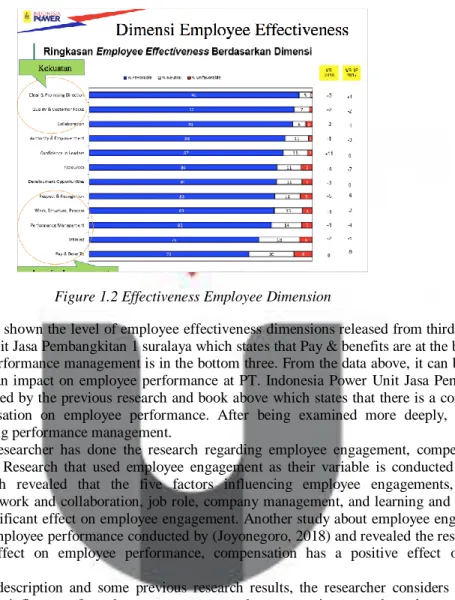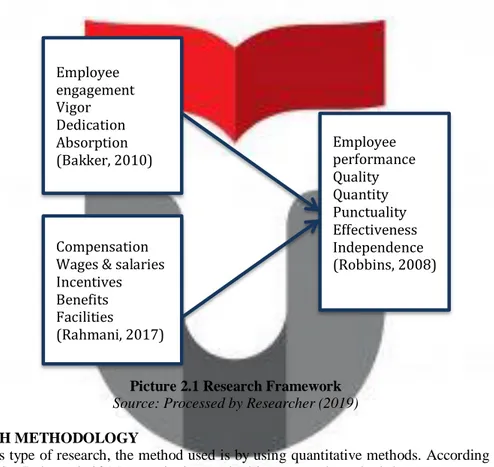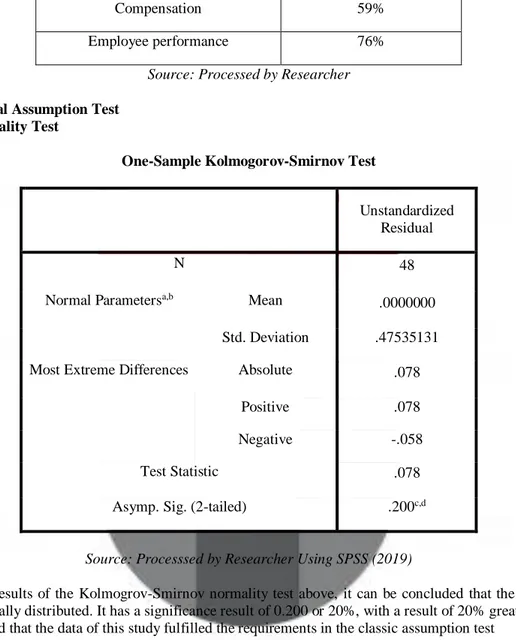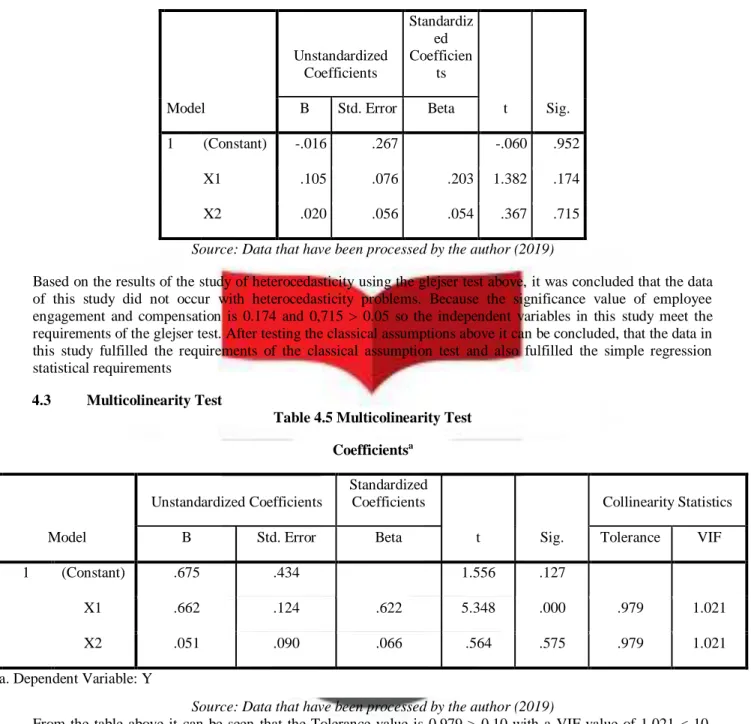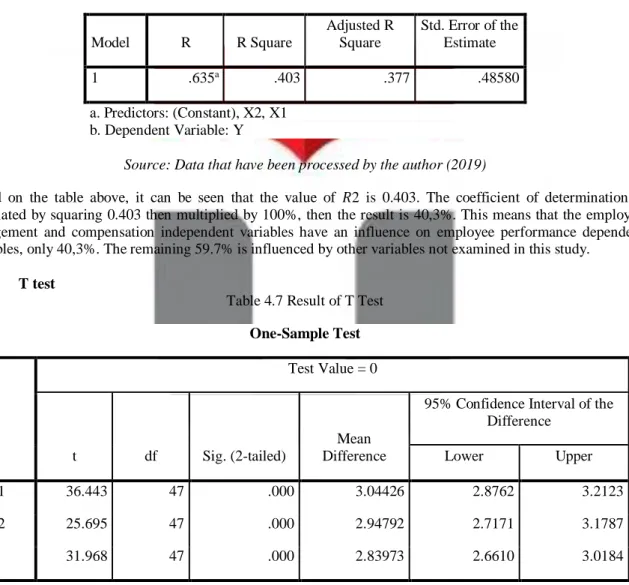THE EFFECT OF EMPLOYEE ENGAGEMENT AND COMPENSATION TOWARD
EMPLOYEE PERFORMANCE
(Studi Kasus PT. INDONESIA POWER UNIT JASA PEMBANGKITAN 1
SURALAYA CILEGON)
1)Shendy Citra, 2) Ella Jauvani Sagala S.Psi., M.Sc Psikolog
1,2) Program Study of International ICT Business, Faculty of Economic and Business, Telkom University 1) shendy.citra01@gmail.com, 2)Ellasagala@telkomuniversity.ac.id
Abstract
Human resource is an important part of the company. Human resource management is the strategic approach to the effective management of people in an organization, so they can help the business gain a competitive advantage. This research was conducted at PT. Indonesia Power Unit Jasa Pembangkitan 1 Suralaya Cilegon Banten with employee engagement and compensation as the independent variables and employee performance as the dependent variable. The population in this study were the employees of PT. Indonesia Power Generation Service Unit 1 Suralaya Cilegon Banten. The method that used in this study is a quantitative method with the aim of descriptive research. Based on the results of the test and data analysis, employee engagement has a significant effect on employee performance with 79% while compensation has a significant effect on employee performance as well with the percentage 59%. Simultaneously, the result revealed that employee engagement and compensation have a significant effect on employee performance.
Keyword: Employee Engagement, Compensation, Employee Performance
1. Introduction
Human resource management is the strategic approach to the effective management of people in an organization, so they can help the business gain a competitive advantage. In gaining a competitive advantage a good employee performance will support the organization to get the objectives.
According to (Sinambela, 2016) employee performance is defined as the ability of employees to do certain skills. Based on the research result of (Joyonegoro, 2018) factors that affecting employee performance are employee engagement and compensation. Employee engagement is a positive, satisfying, affective condition of work-related welfare that can be seen as an antipode of work fatigue (Bakker, 2010). Employee engagement can be interpreted in general as the level of commitment and involvement of employees towards their organization and values. When employees feel involved, the employee will realize his responsibilities in business goals and motivate his colleagues together, for the success of the organization's goals.
Further explained by (Macey, 2009) states that employees who engage will have a desire to be bound which arouses passion for their work, is bound by their work, is willing to sacrifice more energy and time for their work, and become more proactive in achieving their work goals and organizational goals.
Source : Indonesia Power, 2018
Figure 1.1 Level of Employee Engagement at PT. Indonesia Power
The graphic above is explained about the level of employee engagement at PT. Indonesia Power Unit Jasa Pembangkitan 1 Suralaya Based on the graph above, it can be clearly seen that the level of engaged employee is far below than the not engaged employee. It’s means that the level of employee engagement at PT.
Indonesia Power Unit Jasa Pembangkitan 1 Suralaya is low. According to (Joyonegoro, 2018) employee engagement has a positive and significant relationship with employee performance. It means if the employee engagement is low, it will derive the employee performance in low scale as well.
Besides employee engagement, (Joyonegoro, 2018) stated that compensation also affecting employee performance. According to (Masman, 2016) compensation is a broader scope than just wages, namely the total costs incurred for employees which consist of: basic wages, monthly allowances, variable pay, benefits and perks, pension programs, canteens, uniforms and so forth. According to previous research from (Naeem Akhter, 2016) which revealed that there is an effect of compensation on employee performance. This is also supported by the theory of (Milkovich, 2016) book’s, which states that the existence of proper and fair compensation for employees should be able to improve attitudes and behaviors that are not profitable and affect work productivity.
Figure 1.2 Effectiveness Employee Dimension
The data above shown the level of employee effectiveness dimensions released from third parties from PT. Indonesia Power Unit Jasa Pembangkitan 1 suralaya which states that Pay & benefits are at the bottom of the other parameters and performance management is in the bottom three. From the data above, it can be concluded that compensation has an impact on employee performance at PT. Indonesia Power Unit Jasa Pembangkitan 1 Suralaya, this is supported by the previous research and book above which states that there is a connection and the impact of compensation on employee performance. After being examined more deeply, the level of compensation influencing performance management.
Some of the researcher has done the research regarding employee engagement, compensation, and employee performance. Research that used employee engagement as their variable is conducted by (Hassan, 2016 ). The research revealed that the five factors influencing employee engagements, which are, communication, team - work and collaboration, job role, company management, and learning and development have a positive and significant effect on employee engagement. Another study about employee engagement and compensation toward employee performance conducted by (Joyonegoro, 2018) and revealed the result employee engagement positive effect on employee performance, compensation has a positive effect on employee performance.
Based on the description and some previous research results, the researcher considers the need for research on knowing the influence of employee engagement and compensation toward employee performance. Therefore, the author makes a mini thesis with the title “The effect of employee engagement and compensation toward employee performance case study on PT. Indonesia Power Unit Jasa Pembangkitan 1 Suralaya”
In order to increase management performance in PT. Indonesia Power Unit Jasa Pembangkitan 1 Suralaya, the company needs to increase the employee engagement and fix the problem.
In order to increase management performance, employee engagement is essential. Ideal employee engagement usually occurred when the employee satisfied and comfortable while working for the company. Therefore, to provide job satisfaction for the employee, company need to offer several activities, such as conducting training, applying reward and punishment, fulfilling employee rights as a form of compensation for the work that has been done by the employees in achieving the company’s target. (Sleekr, 2016).
2. THEORITICAL BACKGROUND 2.1 Theory summary
2.1.1 Employee Engagement
Work engagement is a positive, fulfilling, affective-motivational state of work-related well-being that can be seen as the antipode of job burnout (Bakker, 2010). Employee engagement is a good tool to help every organization to strive to gain competitive advantage over the others. People is one factor that cannot be
duplicated or imitated by the competitors and is considered the most valuable asset if managed and engaged properly (J., 2014)
2.1.2 Compensation
According to (Masman, 2016) compensation is a broader scope than just wages, namely the total costs incurred for employees which consist of: basic wages, monthly allowances, variable pay, benefits and perks, pension programs, canteens, uniforms and so forth. Compensation is a reward that an employee receives as compensation for his performance in an organization or company. Compensation can be physical or non-physical. Compensation must be calculated and handed over to employees based on sacrifices that are tailored to the performance of employees towards the company (Yusuf, 2018).
2.1.3 Employee Performance
According to (Sinambela, 2016) employee performance is defined as the ability of employees to do certain skills. employee -or job- performance is the achievement and contribution of an individual in practical and quantifiable terms. The performance management is a systematic process of the workload planning and expectations setting, of the continuous performance motorization, development of the performing capacity, periodically performance evaluation and high performance re compensation (United States Office of Personnel Management, 2001) in (Vosloban, 2012).
2.2 Kerangka Pemikiran
Picture 2.1 Research Framework Source: Processed by Researcher (2019)
3. RESEARCH METHODOLOGY
Based on this type of research, the method used is by using quantitative methods. According to (Cooper & Schindler, 2011) in (Indrawati, 2015) quantitative method is a research method that attempts to make accurate measurements of behavior, knowledge, opinions, or attitudes.
Table 3.1 Research Characteristics
No Research characteristics Type
1 Aim Descriptive
2 Method Quantitative
3 Research involvement No interfere
4 Time horizon Cross-sectional
5 Type of investigation Causal
6 Unit of analysis Individual
Source: Processed by Researcher Employee engagement Vigor Dedication Absorption (Bakker, 2010) Compensation Wages & salaries Incentives Benefits Facilities (Rahmani, 2017) Employee performance Quality Quantity Punctuality Effectiveness Independence (Robbins, 2008)
4. RESULT AND DISCUSSION
4.1
Results of Descriptive Statistics Analysis
Table 4.1 Results of Descriptive Statistics Analysis
Variabel Average Percentage
Employee engagement 79%
Compensation 59%
Employee performance 76%
Source: Processed by Researcher 4.4 Classical Assumption Test
4.2.1 Normality Test
One-Sample Kolmogorov-Smirnov Test
Unstandardized Residual
N 48
Normal Parametersa,b Mean
.0000000 Std. Deviation .47535131
Most Extreme Differences Absolute .078
Positive .078
Negative -.058
Test Statistic .078
Asymp. Sig. (2-tailed) .200c,d
Source: Processsed by Researcher Using SPSS (2019)
Based on the results of the Kolmogrov-Smirnov normality test above, it can be concluded that the data of this study are normally distributed. It has a significance result of 0.200 or 20%, with a result of 20% greater than 5%. So, it concluded that the data of this study fulfilled the requirements in the classic assumption test
4.2.2 Autocorrelation Test
Table 4. 3 Result of Autocorrelation test Model Summaryb
Model R R Square Adjusted R Square
Std. Error of the
Estimate Durbin-Watson
1 .283a .080 .060 .43861714 1.892
Source: Processsed by Researcher Using SPSS (2019)
On the table above, it can be seen that there is no autocorrelation because the value of Watson's durbin is between DU and (4-DU).
4.2.3 Heterocedasticity Test
Table 4. 4 Heterocedasticity Test
Coefficients
a Model Unstandardized Coefficients Standardiz ed Coefficien ts t Sig. B Std. Error Beta 1 (Constant) -.016 .267 -.060 .952 X1 .105 .076 .203 1.382 .174 X2 .020 .056 .054 .367 .715Source: Data that have been processed by the author (2019)
Based on the results of the study of heterocedasticity using the glejser test above, it was concluded that the data of this study did not occur with heterocedasticity problems. Because the significance value of employee engagement and compensation is 0.174 and 0,715 > 0.05 so the independent variables in this study meet the requirements of the glejser test. After testing the classical assumptions above it can be concluded, that the data in this study fulfilled the requirements of the classical assumption test and also fulfilled the simple regression statistical requirements
4.3 Multicolinearity Test
Table 4.5 Multicolinearity Test Coefficientsa Model Unstandardized Coefficients Standardized Coefficients t Sig. Collinearity Statistics
B Std. Error Beta Tolerance VIF
1 (Constant) .675 .434 1.556 .127
X1 .662 .124 .622 5.348 .000 .979 1.021
X2 .051 .090 .066 .564 .575 .979 1.021
a. Dependent Variable: Y
Source: Data that have been processed by the author (2019)
From the table above it can be seen that the Tolerance value is 0.979 > 0.10 with a VIF value of 1.021 < 10, which means that there is no multicollinearity between independent variables.
4.4 Multiple Linear Regression
Table 4.6 Result of Multiple Linear Regression Coefficientsa Model Unstandardized Coefficients Standardized Coefficients t Sig. B Std. Error Beta 1 (Constant) .675 .434 1.556 .127 Engagement .662 .124 .622 5.348 .000 Compensation .051 .090 .066 .564 .575
The dependent variable in this study is employee performance, while the independent variables in this study are employee engagement and compensation. The regression model in this study is Y (employee performance) = 0.675 + 0.662 (employee engagement) + 0,051 (compensation). Based on these data, it can be said that if employee engagement and employee commitment have a value of 0 then the value of employee performance is 0.675. In addition, it can be concluded also if the value of employee engagement increases, employee performance will increase. Vice versa, if the value of employee engagement decreases, the employee's performance will decrease. The same thing also happened to the compensation variable. If the compensation value increases, the employee's performance will increase, and if the compensation value drops, the employee's performance will decrease. It can be concluded also, based on the data in the table that employee engagement provides greater value and influence than employee commitment.
4.6 Hyphothesis Testing
4.6.2 Coefficient Determination
Table 4.7 Result of Coefficient Determination Model Summaryb Model R R Square Adjusted R Square Std. Error of the Estimate 1 .635a .403 .377 .48580 a. Predictors: (Constant), X2, X1 b. Dependent Variable: Y
Source: Data that have been processed by the author (2019)
Based on the table above, it can be seen that the value of 𝑅2 is 0.403. The coefficient of determination is calculated by squaring 0.403 then multiplied by 100%, then the result is 40,3%. This means that the employee engagement and compensation independent variables have an influence on employee performance dependent variables, only 40,3%. The remaining 59.7% is influenced by other variables not examined in this study.
4.6.2 T test
Table 4.7 Result of T Test One-Sample Test
Test Value = 0
t df Sig. (2-tailed)
Mean Difference
95% Confidence Interval of the Difference
Lower Upper
X1 36.443 47 .000 3.04426 2.8762 3.2123
X2 25.695 47 .000 2.94792 2.7171 3.1787
Y 31.968 47 .000 2.83973 2.6610 3.0184
Source: Data that have been processed by the author (2019)
On one-sample test, the result of p value must be < 0.001 so then we can reject null hypothesis. Based on the data above, the result of p value (sig. (2-tailed)) are all below 0.001. Means that we reject null hypothesis and accept Ha. Employee engagement and compensation have a significant effect on employee performance partially.
4.6.3 F test
Table 4.8 Result of F Test ANOVAa
Model Sum of Squares df Mean Square F Sig.
1 Regression 7.182 2 3.591 15.215 .000b
Residual 10.620 45 .236
Total 17.802 47
a. Dependent Variable: Y b. Predictors: (Constant), X2, X1
Source: Data that have been processed by the author (2019)
On the table above, it can clearly be seen that P value score is <0.05. Null hypothesis is rejected and it means that employee engagement and compensation have significant effect on employee performance simultaneously. 5. Conclusion and Suggestion
5.1 Conclusion
a Employee engagement variables at PT. Indonesia Power Unit 1 Generation Services Suralaya, included in the high category with results reaching 79%. This shows that the implementation of Employee engagement in this company has been fairly good but need to be increased by giving training, caring, outbound training, and accept employees who are in accordance with the company's vision.
b Compensation at PT. Indonesia Power Service Unit 1 Generation Suralaya, included in the moderate category with a result of 59%. This shows that the application of compensation in this company needs improvement by have a salary increase that is in accordance with the workload of employees by making salary adjustments based on workload, achievement, and achievement of the target that the company has given.
c Employee performance at PT. Indonesia Power Unit Service Generation 1 Suralaya, included in the high category with results reaching 76%. This shows that Employee performance in this company is already fairly good but need to be increased by giving training, facilities, good compensation, good environment, good carrier, and fulfill employee rights.
d Engagement variable has a significant partial effect on employee performance. The effect of employee engagement on employee performance is 36.7%. This shows that employee engagement affects the performance of employees at PT. Indonesia Power Unit Service Generation 1 Suralaya is 36.7% and the remaining 63.3% is influenced by other variables not examined in this study such as motivation, turnover intention, and employee satisfaction.
e According to the test results, compensation variable has a significant effect on employee performance. The effect of compensation on employee performance is 36.7%. This shows that compensation affects the performance of employees at PT. Indonesia Power Unit Service Generation 1 Suralaya is 36.7% and the remaining 63.3% is influenced by other variables not examined in this study such as motivation, turnover intention, and employee satisfaction.
f According to the results of testing simultaneously, it can be concluded that employee engagement and compensation have a significant effect on the performance of employee generation y at PT. Indonesia Power Unit Service Generation 1 Suralaya. This shows that the application of employee engagement and compensation at PT. Indonesia Power Unit 1 Generation Services Suralaya has been fairly good. 5.2 Suggestion
5.2.1 Practical Aspect
a. Based on the results of research, employee engagement at PT. Indonesia Power Unit 1 Generation Suralaya Service is high. Engagement with employees is very necessary, because employees who engage with their companies can face the demands of their work properly. The company should create a conducive work environment and in accordance with the characteristics of existing employees, in order to create comfort for employees, because PT. Indonesia Power Unit Service Generation 1 Suralaya is dominated by male employees and has the highest S1 graduation rate. Improving the work environment in order to create comfort for employees, can be done by improving office interiors to be more attractive, the use of more modern technology, providing facilities needed by employees to feel easier in completing their work and improve good relations between co-workers to create comfort in work environment.
b. Based on the results of the research, compensation at PT. Indonesia Power Service Unit 1 Suralaya is classified as an intermediate position. Compensation is needed because; employees who have good compensation will work well and are more attached to employees because what has been issued is directly proportional to what is obtained. Based on data processing that has been done by the author, it is necessary to improve the compensation for employees at PT. Indonesia Power Unit Service Generation 1 Suralaya.
c. Based on the results of research, the performance of employees at PT. Indonesia Power Service Unit 1 Suralaya is classified as high. Employee performance is needed to improve organizational progress. Companies should create good work procedures and good work timelines to facilitate employee performance. So that employees can complete their tasks on time and are not neglected. In accordance with the character of the employees in the company, namely the age of young and S1 graduates, the employees are capable of technology, the company can advise employees to use several applications such as Google Calendar, aCalender, and Reminders to make it easier for employees to remember their work time or work deadlines. Because the timeliness of employees in completing their work will affect other jobs, and also affect the company's performance.
5.2.2 Theoretical Aspect
a Future researchers are hoped to use other variables such as organizational culture, leadership, compensation, work stress, and other variables due to the result revealed that employee engagement and compensation affect employee performance by 36.7%, the remaining 63.3% is influenced by other factors not explained in the study. Another choice is similar research can be conducted, but try to use another measuring instruments in order to provide a broader understanding of employee engagement, compensation and employee performance. Future researchers also can expand the research object to other companies in Indonesia. DAFTAR PUSTAKA
[1] Sinambela, P. D. (2016). Manajemen Sumber Daya Manusia: Membangun Tim Kerja Yang Solid Untuk Meningkatkan Kinerja. (S. d. Damayanti, Ed.) Jakarta, Indonesia: PT. Bumi Aksara.
[2] Joyonegoro, S. H. (2018). Pengaruh Employee Engagement dan Kompensasi Terhadap Kinerja Karyawan dengan Kepuasan Kerja Sebagai Variabel Intervening Pada Pegawai Balai Besar Rehabilitasi Sosial Bina Grahita (BBRSBG) Kartini Kabupaten Temanggung . Sumber Daya Manusia.
[3] Macey, W. S. (2009). Employee Engagement: Tools for Analysis, Practice, and Competitive Advantage. [4] Masman, Y. S. (2016). A Practical Guidance to Executive Compensation Management. (Fathurizqi, Ed.) Jakarta, DKI, Indonesia: PT Elex Media Komputindo.
[5] Naeem Akhter, a. a. (2016, 6). Impact of Compensation Discrimination on Employees Performance in Engro Food Limited, Alhamd Food Limited and Leader industry Sahiwal of Pakistan. International Review of Management and Business Research, 5(2).
[6] Milkovich, G. T. (2016). Compensation 12th Edition. London, England: McGraw-Hill Education.
[7] Hassan, F. M. (2016 , 4). Factors influencing Employee Engagement: A study on a Telecommunication Network provider in Maldives . International Journal of Accounting & Business Management , 4(1).
[8] Sleekr. (2016, 1 21). Sleekr. Retrieved 10 10, 2018, from Sleekr website: https://sleekr.co/blog/6-tips-meningkatkan-kinerja-karyawan/
[9] Bakker, M. P. (2010). Work Engagement A Handbook of Essential Theory and Research . New York , America: Psychology Press.
[10] J., A. (2014, 8 6). Determinants of employee engagement and their impact on employee performance. Productivity and Performance Management, 63(3), 308-323.
[11] Yusuf. (2018, 8 31). Jurnal Manajemen. Retrieved 10 19, 2018, from Jurnal Manajemen Website: http://jurnalmanajemen.com/pengertian-kompensasi/
[12] Vosloban, R. I. (2012). The Influence of the Employee's Performance on the company's growth - a managerial perspective. Emerging Market Queries in Finance and Business.
[13] Rahmani, A. (2017, 11 22). Jurnal ID. Retrieved 10 19, 2018, from Jurnal ID Website: https://www.jurnal.id/id/blog/2017/tujuan-bentuk-jenis-dan-faktor-yang-memengaruhi-kompensasi-perusahaan [14] Indrawati, P. (2015). Metode penelitian manajemen dan bisnis konvergensi teknologi komunikasi dan informasi (Vol. 1). (D. sumayyah, Ed.) Bandung, West java, Indonesia: PT Refika Aditama.
